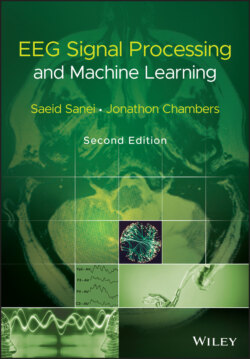Читать книгу EEG Signal Processing and Machine Learning - Saeid Sanei - Страница 2
Table of Contents
Оглавление1 Cover
2 Title Page
3 Copyright Page
4 Preface to the Second Edition
5 Preface to the First Edition
6 List of Abbreviations
7 1 Introduction to Electroencephalography 1.1 Introduction 1.2 History 1.3 Neural Activities 1.4 Action Potentials 1.5 EEG Generation 1.6 The Brain as a Network 1.7 Summary References
8 2 EEG Waveforms 2.1 Brain Rhythms 2.2 EEG Recording and Measurement 2.3 Sleep 2.4 Mental Fatigue 2.5 Emotions 2.6 Neurodevelopmental Disorders 2.7 Abnormal EEG Patterns 2.8 Ageing 2.9 Mental Disorders 2.10 Summary References
9 3 EEG Signal Modelling 3.1 Introduction 3.2 Physiological Modelling of EEG Generation 3.3 Generating EEG Signals Based on Modelling the Neuronal Activities 3.4 Mathematical Models Derived Directly from the EEG Signals 3.5 Electronic Models 3.6 Dynamic Modelling of Neuron Action Potential Threshold 3.7 Summary References
10 4 Fundamentals of EEG Signal Processing 4.1 Introduction 4.2 Nonlinearity of the Medium 4.3 Nonstationarity 4.4 Signal Segmentation 4.5 Signal Transforms and Joint Time–Frequency Analysis 4.6 Empirical Mode Decomposition 4.7 Coherency, Multivariate Autoregressive Modelling, and Directed Transfer Function 4.8 Filtering and Denoising 4.9 Principal Component Analysis 4.10 Summary References
11 5 EEG Signal Decomposition 5.1 Introduction 5.2 Singular Spectrum Analysis 5.3 Multichannel EEG Decomposition 5.4 Sparse Component Analysis 5.5 Nonlinear BSS 5.6 Constrained BSS 5.7 Application of Constrained BSS; Example 5.8 Multiway EEG Decompositions 5.9 Tensor Factorization for Underdetermined Source Separation 5.10 Tensor Factorization for Separation of Convolutive Mixtures in the Time Domain 5.11 Separation of Correlated Sources via Tensor Factorization 5.12 Common Component Analysis 5.13 Canonical Correlation Analysis 5.14 Summary References
12 6 Chaos and Dynamical Analysis 6.1 Introduction to Chaos and Dynamical Systems 6.2 Entropy 6.3 Kolmogorov Entropy 6.4 Multiscale Fluctuation‐Based Dispersion Entropy 6.5 Lyapunov Exponents 6.6 Plotting the Attractor Dimensions from Time Series 6.7 Estimation of Lyapunov Exponents from Time Series 6.8 Approximate Entropy 6.9 Using Prediction Order 6.10 Summary References
13 7 Machine Learning for EEG Analysis 7.1 Introduction 7.2 Clustering Approaches 7.3 Classification Algorithms 7.4 Common Spatial Patterns 7.5 Summary References
14 8 Brain Connectivity and Its Applications 8.1 Introduction 8.2 Connectivity through Coherency 8.3 Phase‐Slope Index 8.4 Multivariate Directionality Estimation 8.5 Modelling the Connectivity by Structural Equation Modelling 8.6 Stockwell Time–Frequency Transform for Connectivity Estimation 8.7 Inter‐Subject EEG Connectivity 8.8 State‐Space Model for Estimation of Cortical Interactions 8.9 Application of Cooperative Adaptive Filters 8.10 Graph Representation of Brain Connectivity 8.11 Tensor Factorization Approach 8.12 Summary References
15 9 Event‐Related Brain Responses 9.1 Introduction 9.2 ERP Generation and Types 9.3 Detection, Separation, and Classification of P300 Signals 9.4 Brain Activity Assessment Using ERP 9.5 Application of P300 to BCI 9.6 Summary References
16 10 Localization of Brain Sources 10.1 Introduction 10.2 General Approaches to Source Localization 10.3 Head Model 10.4 Most Popular Brain Source Localization Approaches 10.5 Forward Solutions to the Localization Problem 10.6 The Methods Based on Source Tracking 10.7 Determination of the Number of Sources from the EEG/MEG Signals 10.8 Other Hybrid Methods 10.9 Application of Machine Learning for EEG/MEG Source Localization 10.10 Summary References
17 11 Epileptic Seizure Prediction, Detection, and Localization 11.1 Introduction 11.2 Seizure Detection 11.3 Chaotic Behaviour of Seizure EEG 11.4 Seizure Detection from Brain Connectivity 11.5 Prediction of Seizure Onset from EEG 11.6 Intracranial and Joint Scalp–Intracranial Recordings for IED Detection 11.7 Fusion of EEG–fMRI Data for Seizure Prediction 11.8 Summary References
18 12 Sleep Recognition, Scoring, and Abnormalities 12.1 Introduction 12.2 Stages of Sleep 12.3 The Influence of Circadian Rhythms 12.4 Sleep Deprivation 12.5 Psychological Effects 12.6 EEG Sleep Analysis and Scoring 12.7 Detection and Monitoring of Brain Abnormalities during Sleep by EEG and Multimodal PSG Analysis 12.8 Dreams and Nightmares 12.9 EEG and Consciousness 12.10 Functional Brain Connectivity for Sleep Analysis 12.11 Summary References
19 13 EEG‐Based Mental Fatigue Monitoring 13.1 Introduction 13.2 Feature‐Based Machine Learning Approaches 13.3 Measurement of Brain Synchronization and Coherency 13.4 Evaluation of ERP for Mental Fatigue 13.5 Separation of P3a and P3b 13.6 A Hybrid EEG–ERP‐Based Method for Fatigue Analysis Using an Auditory Paradigm 13.7 Assessing Mental Fatigue by Measuring Functional Connectivity 13.8 Deep Learning Approaches for Fatigue Evaluation 13.9 Summary References
20 14 EEG‐Based Emotion Recognition and Classification 14.1 Introduction 14.2 Effect of Emotion on the Brain 14.3 Emotion‐Related Brain Signal Processing and Machine Learning 14.4 Other Physiological Measurement Modalities Used for Emotion Study 14.5 Applications 14.6 Pain Assessment Using EEG 14.7 Emotion Elicitation and Induction through Virtual Reality 14.8 Summary References
21 15 EEG Analysis of Neurodegenerative Diseases 15.1 Introduction 15.2 Alzheimer's Disease 15.3 Motor Neuron Disease 15.4 Parkinson's Disease 15.5 Huntington's Disease 15.6 Prion Disease 15.7 Behaviour Variant Frontotemporal Dementia 15.8 Lewy Body Dementia 15.9 Summary References
22 16 EEG As A Biomarker for Psychiatric and Neurodevelopmental Disorders 16.1 Introduction 16.2 EEG Analysis for Different NDDs 16.3 Summary References
23 17 Brain–Computer Interfacing Using EEG 17.1 Introduction 17.2 BCI‐Related EEG Components 17.3 Major Problems in BCI 17.4 Multidimensional EEG Decomposition 17.5 Detection and Separation of ERP Signals 17.6 Estimation of Cortical Connectivity 17.7 Application of Common Spatial Patterns 17.8 Multiclass Brain–Computer Interfacing 17.9 Cell‐Cultured BCI 17.10 Recent BCI Applications 17.11 Neurotechnology for BCI 17.12 Joint EEG and Other Brain‐Scanning Modalities for BCI 17.13 Performance Measures for BCI Systems 17.14 Summary References
24 18 Joint Analysis of EEG and Other Simultaneously Recorded Brain Functional Neuroimaging Modalities 18.1 Introduction 18.2 Fundamental Concepts 18.3 Joint EEG–fMRI 18.4 EEG–NIRS Joint Recording and Fusion 18.5 MEG–EEG Fusion 18.6 Summary References
25 Index
26 End User License Agreement
